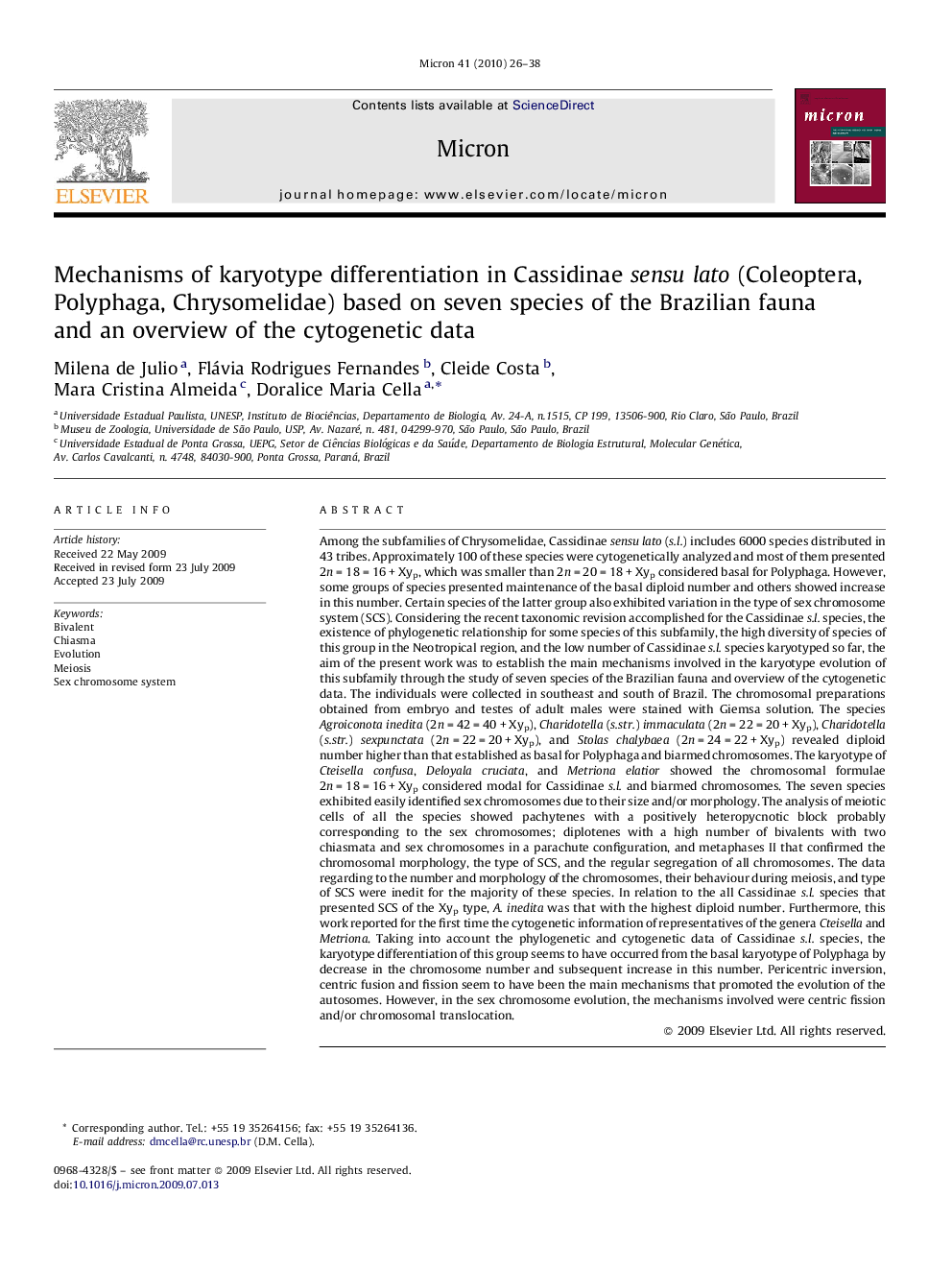| کد مقاله | کد نشریه | سال انتشار | مقاله انگلیسی | نسخه تمام متن |
|---|---|---|---|---|
| 1589576 | 1002001 | 2010 | 13 صفحه PDF | دانلود رایگان |

Among the subfamilies of Chrysomelidae, Cassidinae sensu lato (s.l.) includes 6000 species distributed in 43 tribes. Approximately 100 of these species were cytogenetically analyzed and most of them presented 2n = 18 = 16 + Xyp, which was smaller than 2n = 20 = 18 + Xyp considered basal for Polyphaga. However, some groups of species presented maintenance of the basal diploid number and others showed increase in this number. Certain species of the latter group also exhibited variation in the type of sex chromosome system (SCS). Considering the recent taxonomic revision accomplished for the Cassidinae s.l. species, the existence of phylogenetic relationship for some species of this subfamily, the high diversity of species of this group in the Neotropical region, and the low number of Cassidinae s.l. species karyotyped so far, the aim of the present work was to establish the main mechanisms involved in the karyotype evolution of this subfamily through the study of seven species of the Brazilian fauna and overview of the cytogenetic data. The individuals were collected in southeast and south of Brazil. The chromosomal preparations obtained from embryo and testes of adult males were stained with Giemsa solution. The species Agroiconota inedita (2n = 42 = 40 + Xyp), Charidotella (s.str.) immaculata (2n = 22 = 20 + Xyp), Charidotella (s.str.) sexpunctata (2n = 22 = 20 + Xyp), and Stolas chalybaea (2n = 24 = 22 + Xyp) revealed diploid number higher than that established as basal for Polyphaga and biarmed chromosomes. The karyotype of Cteisella confusa, Deloyala cruciata, and Metriona elatior showed the chromosomal formulae 2n = 18 = 16 + Xyp considered modal for Cassidinae s.l. and biarmed chromosomes. The seven species exhibited easily identified sex chromosomes due to their size and/or morphology. The analysis of meiotic cells of all the species showed pachytenes with a positively heteropycnotic block probably corresponding to the sex chromosomes; diplotenes with a high number of bivalents with two chiasmata and sex chromosomes in a parachute configuration, and metaphases II that confirmed the chromosomal morphology, the type of SCS, and the regular segregation of all chromosomes. The data regarding to the number and morphology of the chromosomes, their behaviour during meiosis, and type of SCS were inedit for the majority of these species. In relation to the all Cassidinae s.l. species that presented SCS of the Xyp type, A. inedita was that with the highest diploid number. Furthermore, this work reported for the first time the cytogenetic information of representatives of the genera Cteisella and Metriona. Taking into account the phylogenetic and cytogenetic data of Cassidinae s.l. species, the karyotype differentiation of this group seems to have occurred from the basal karyotype of Polyphaga by decrease in the chromosome number and subsequent increase in this number. Pericentric inversion, centric fusion and fission seem to have been the main mechanisms that promoted the evolution of the autosomes. However, in the sex chromosome evolution, the mechanisms involved were centric fission and/or chromosomal translocation.
Journal: Micron - Volume 41, Issue 1, January 2010, Pages 26–38